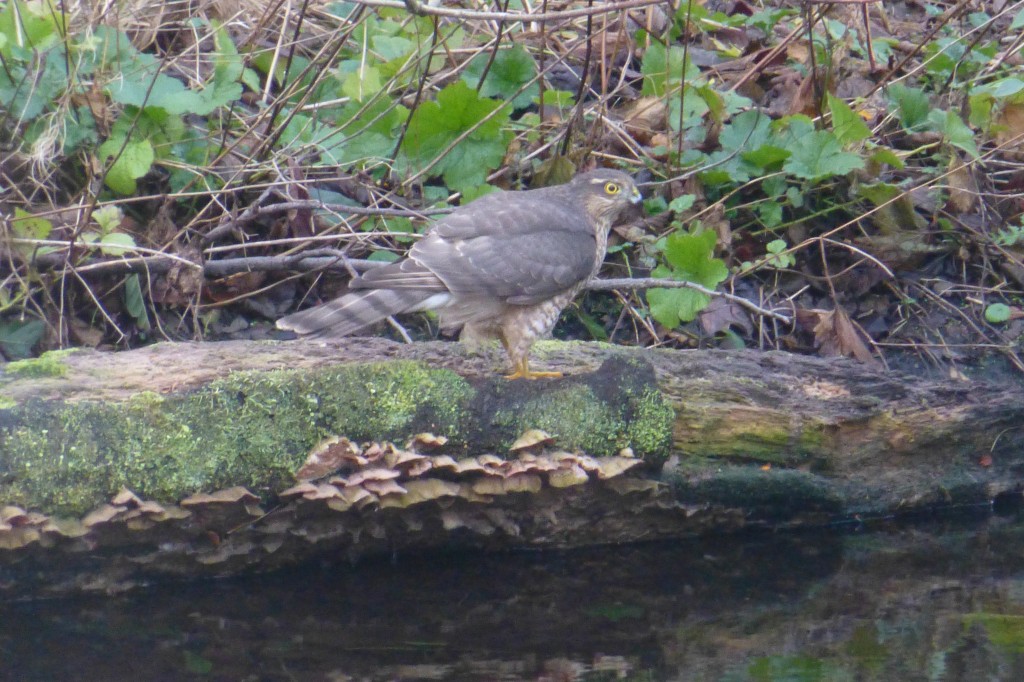Over the past four years I have been very fortunate to have been able to observe the activities of the sparrowhawks (Gaelic: speireag) in the garden. These beautiful birds are a wonder to behold and have nested and bred successfully here on a number of occasions. I hope to be able to provide more regular updates on their activities over the course of the year. There is a webpage dedicated to them on the RSPB website which is at:
I have already posted the RBGE Sparrowhawk Diary for 2014 on Botanic Stories and this is to be a continuation. So, to give an update since then, over the winter there were a number of times I saw sparrowhawks in the garden, particularly as they seemed to been having a lot of run-ins with the resident crows. There was one particularly notable sighting around the end of December where I saw a pair of Sparrowhawks, a male and female who were quite clearly distinguishable by their size, flying with aerial acrobatics over the Chinese Hillside. They continued to be active through the winter months especially on the west side of the garden and then towards the beginning of May it became apparent that nesting was a possibility. Unfortunately some broken egg shells were also found around this time which were freshly laid as they were still a bluish colour and not the white which they go after time. This is the way of nature though, it can be tough sometimes. However since then there have been indications that another attempt has been made at nesting so I will keep you posted.
Sparrowhawks are one of the species listed on the Edinburgh Council Notable Rare Species list and actions with regard to sparrowhawks appear in the current Local Biodiversity Action Plan under the Lowland and Urban section. There is a specific action point (LU20) which defines actions to be taken jointly between the Lothian & Borders Raptor Study Group and the RBGE.
Another intitiative which has begun recently is the Edinburgh Living Landscape project and this also involves a collaboration between the RBGE and many other partners to enhance the urban biodiversity in the city. Sparrowhawks are, and I hope will continue to be, a part of the complex web of relationships that make up the landscape we live in.


Drew McNaughton
The second post of the Botanics Sparrowhawks blog – Sparrowhawks and Trees:
http://stories.rbge.org.uk/archives/15644
Drew McNaughton
The third post of the Botanics Sparrowhawks blog – Welcome to the World:
http://stories.rbge.org.uk/archives/16161
Drew McNaughton
The fourth post of the Botanics Sparrowhawks blog – Keeping Track:
http://stories.rbge.org.uk/archives/16306
Drew McNaughton
The fifth post of the Botanics Sparrowhawks blog – What’s that noise?
http://stories.rbge.org.uk/archives/16560
Drew McNaughton
The sixth post of the Botanics Sparrowhawks blog – Yardstick of Success.
http://stories.rbge.org.uk/archives/16821
Drew McNaughton
The seventh post of the Botanics Sparrowhawks blog – Latest Observations.
http://stories.rbge.org.uk/archives/16986
Drew McNaughton
The eighth post of the Botanics Sparrowhawks blog – Autumn Action
http://stories.rbge.org.uk/archives/17477
Drew McNaughton
The ninth post of the Botanics Sparrowhawks blog – Related Projects
http://stories.rbge.org.uk/archives/17479
Drew McNaughton
The tenth post of the Botanics Sparrowhawks blog – Added Inspiration
http://stories.rbge.org.uk/archives/17652
Drew McNaughton
The eleventh post of the Botanics Sparrowhawks blog – Tweets
http://stories.rbge.org.uk/archives/18230
Drew McNaughton
The twelveth post of the Botanics Sparrowhawks blog – Species Reproduction
http://stories.rbge.org.uk/archives/18820
Drew McNaughton
The thirteenth post of the Botanics Sparrowhawks blog – Living Landscapes Event Sun 14/02/2016
http://stories.rbge.org.uk/archives/18969
Drew McNaughton
The fourteenth post of the Botanics Sparrowhawks blog – Easter Trail Bird Biodiversity
http://stories.rbge.org.uk/archives/19546